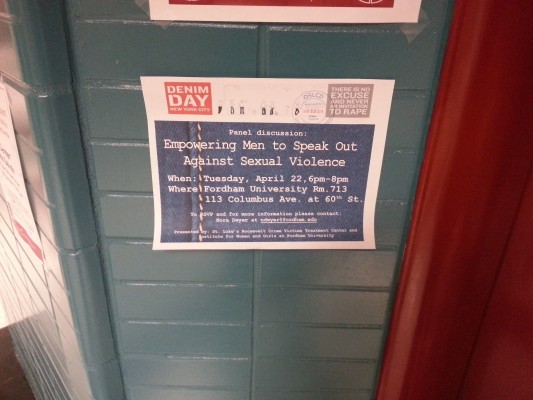Gap in Reported Sexual Assaults at Fordham
May 2, 2014

According to the Office of Postsecondary Education (OPE) in the United States Department of Education, Fordham’s sexual assault incidence rate, that is incidents per student population, is approximately .00151 from 2010 to 2012. However, according to the White House report, “Rape and Sexual Assault: A Renewed Call to Action,” one in five women have been sexually assaulted in college.
Under the conditions of this statistic and Fordham’s 53 percent female population (out of a 15,170 total), the 23 sexual assault incidents reported at Fordham from 2010 to 2012 seems extremely low. On Tuesday, April 29th, Vice President Joe Biden said, “Colleges and universities can no longer turn a blind eye or pretend rape or sexual assault doesn’t occur on their campuses.”
“We are transparent with everything that gets officially reported to us. Anything that comes to someone who is classified as a campus security authority, that language comes out of the Clery Act, is obligated to report to security. That includes pretty much everyone involved in student affairs, ” Dean of Students at Lincoln Center Keith Eldredge said.
The Jeanne Clery Disclosure of Campus Security Policy and Campus Crime Statistics, also known as the Clery Act, signed in 1990, requires all college and universities that receive federal financial aid to record and disclose yearly crime information on and near their respective campuses. These statistics can be found online at the Department of Education’s website, and criminal offenses are broken down by nine categories. Two of the nine categories deal with sex offenses, forcible (any sexual act when the victim is incapable of giving consent) and non-forcible (any unlawful, non-forcible sexual intercourse).
“I think the bigger reason for the low statistics is people not feeling comfortable enough to report and that’s the biggest gap we have,” Eldredge said.
Fordham Security Operations Investigator Patricia Upton echoed the sentiment that getting people to come forward to report is one of the biggest difficulties.
“I think [victims] fear the unknown. I think if they start becoming educated as to what the process is, their fear won’t be as heightened because there’s a lot of questions. I think it won’t be as overwhelming if we go through the process together,” Upton said, “but in order to get to that point, the victim has to feel comfortable to come to us.”
In regards to making students feel more comfortable reporting incidents of sexual assault, Eldredge said, “I always look to partner with students on those kinds of initiatives.”
“I know that the administrative program, the top-down program that I plan and I put together is not going to get the same amount of response or participation that grass roots level, that students put together, would have,” Eldredge said.
A student at Fordham College at Lincoln Center (FCLC) who chose to remain anonymous decided to come forward a year after she experienced a female-to-female sexual assault on campus. “I only decided to come forward with it when I found out that she had attacked multiple people,” she said.
“I was told by ResLife that should I choose to issue a statement I would have to wait for the female security supervisor to come down from Rose Hill, which took about two weeks to schedule that appointment,” she said. “Although that was mostly just tag back and forth because of busy schedules,” she clarified.
According to Fordham policy, students have to officially report incidents with a security safety supervisor, however, the supervisor is not required to be the same gender as the alleged victim.
When reporting a sexual assault incident to a security supervisor, “if you feel more comfortable talking to a male, we’ll give you a male. If you feel more comfortable talking to a female, we’ll give you a female,” John Carroll, associate vice president of safety and security, said.
Carroll could not confirm nor respond as to where the miscommunication in policy arose. “ResLife is a big word. It could be anybody. I can’t comment on that,” Carroll said, “all I can say in response is that’s not true.” The office of Residential Life at Lincoln Center was not able to comment.
The student suggested having a female security supervisor on the Lincoln Center campus as one way to help female victims come forward. “They could station a security guard that you could report sexual assault to 24/7 on our campus. I think it’s kind of absurd they don’t have a female security supervisor for a campus that has a 70 percent female population,” she said.
Carroll disagrees with the necessity of having a female security supervisor at the Lincoln Center campus. “Everyone of these women have vehicles here [at Rose Hill] and can be at Lincoln Center as fast as some of the RD’s can be down from the 12th floor in McMahon,” he said.
“I think there’s confusion a lot of the time when a student wishes to speak about something that happened in the past. When it comes to any sexual offense, I’m normally involved at some point in the investigation, so that might be where the confusion is, but I’m certainly not the only [female security supervisor],” Upton said.
“There are 54 Safety and Security administrators at Fordham University, eight of whom are females,” Carroll said. Lincoln Center currently has no female security supervisors on campus.
“We try to give as many options and try to do things that make people feel more comfortable so part of what we will try to do is offer the same gender security person,” Eldredge explained.
“There is a lot of victim blaming that happens in the culture, there’s a lot of individuals that blame themselves, when something happens so we want to make it as comfortable as possible to come forward,” Eldredge said.
“Sexual assaults are assaults,” Carroll said. “An attack. A victim, male or female, can’t bring on an assault. The person, who we would call a perpetrator caused it, you can’t ever blame the victim,” he explained.
Correction: The published article used the phrase “incident rate” and the author has changed the online edition to “incidence rate.” In addition, instead of citing the approximate incidence rate for females at Fordham University, the number of reported assaults was used instead.












anonymous student searching for truth • May 2, 2014 at 1:45 pm
MY CRITIQUE OF THIS ARTICLE
I think it is important to consider all of the potential factors that may pertain uniquely to Fordham before making an assumption regarding the discrepancy between the national rate of sexual assault of females in college and the rate specific with Fordham. It is also important to note that Fordham was not mentioned on the recent US DoE inquiry investigating colleges’ inappropriate handling of sexual violence and harassment complaints which leads one to believe that Fordham could very well fall below the national average. Although one would be benighted to believe that the reported incidence* rate of any sexual crime would be spot on accurate (as it is just the ugly truth that sex violence is always going to go under-reported) I would be willing wager that the true rate of sexual violence at Fordham is actually closer to the DoE approximation then the White House report. Another important piece of information you forgot to include from your source, “A Renewed Call to Action to End Rape and Sexual Assault” is the incidence rate of sexual assault in the male population, which your source puts the national average at 1 in 71. By calculating the incidence rate of sexual assault for males at Fordham using the national average and then calculating the combined weighted average of the incidence rates of men and women, the new combined incidence rate in .056. This number, despite still being significantly higher than OPE rate of .00151 makes a bit more sense. Now .056 is the national average, but I can think of a couple reasons why Fordham would find itself well below the national average. First and foremost, Fordham doesn’t have a greek system. The modern college greek system has become a cesspool of inappropriate sexual conduct. Growing up in a major college town (home to one of the most prestigious state schools in the country) I remember frequently hearing about fraternities being sanctioned and members being arrested for crimes related to sexual assault. I know for a fact that the school I grew up around is inflating your 1 in 5 women stat and I can only imagine that some of the less savory “big” schools inflate this statistic even further. Secondly, Fordham is a Catholic school which does have some relevance. For instance, at Fordham one may not have overnight guests of the opposite sex. now, I’m not in denial with the fact that this rule can be circumvented fairly easily, but by controlling overnight guests the school is minimizing the occurrence of situations that are likely to lead to sexual assault. I do not have all of the data necessary to calculate the rate of incidence all the way down to the DoE number; however, I think its fairly easy to conclude based on the numbers supplied in your article that the data provided by the Department of Education is, in all likelihood, more accurate than the blanket number released by the White House. The way the writer of this article is using the White House statistic of 1 in 5 is like saying the combined rate of robbery in all five of NYC’s boroughs is 1 in 5, I live on Central Park West but I run the same risk of getting robbed as someone living in Brownsville Brooklyn because we are both part of NYC. Just food for thought.